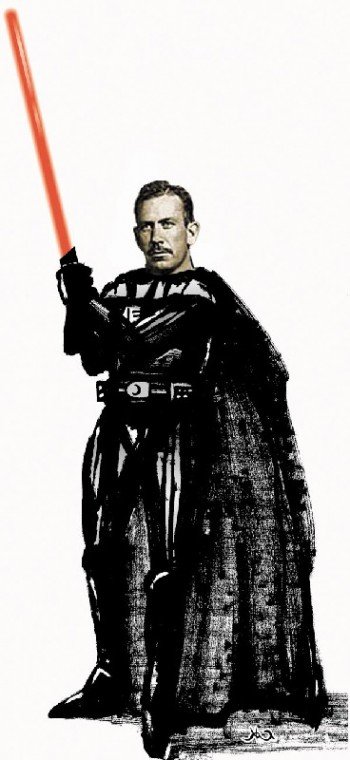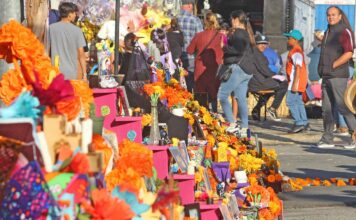Given that his story takes place
”
a long time ago, in a galaxy far, far away,
”
you’d probably never dream Darth Vader has a very real
connection to Hollister.
But thanks to research done by the San Benito County Historical
Society, I can assure you with complete confidence that without
Hollister
– and Nobel Prize-winning author John Steinbeck – the
blockbuster
”
Star Wars
”
series might never have come to a megaplex cinema near you.
Given that his story takes place “a long time ago, in a galaxy far, far away,” you’d probably never dream Darth Vader has a very real connection to Hollister.
But thanks to research done by the San Benito County Historical Society, I can assure you with complete confidence that without Hollister – and Nobel Prize-winning author John Steinbeck – the blockbuster “Star Wars” series might never have come to a megaplex cinema near you.
Am I implying the home of the Haybalers is also the hometown of Darth Vader, the galaxy’s most feared villain? Well … kind of. Surprisingly, the San Benito County community played a very important indirect role in creating the character of Anakin Skywalker – the psychologically dark dude who joins the “Dark Side” and becomes Darth Vader in today’s release of “Star Wars Episode III: The Revenge of the Sith.”
And just like the “Star Wars” narrative, Hollister’s own connection to Darth Vader has a fascinating backstory …
Episode I: A New Hope
Our saga starts “a long time ago” – on November 25, 1874 to be exact. That’s the day a Victorian woman named Almira Steinbeck and her six sons arrived by train at the Hollister depot station. There, she met her husband John Adolph Steinbeck.
A year earlier, with hopes of starting a better life out west, he’d left the family home in Leominster, Mass., and journeyed to California. A carpenter by trade, he learned about a new town being built in California – a farming community named after a certain gentleman called Colonel William Hollister. After he established himself here in Hollister, John brought his wife and kids across the country to settle here.
According to a San Benito Historical Society report titled “History of the Steinbeck Family,” John and Almira purchased a 10-acre plot of land in town and moved into a two-story Victorian home on Line Street. John at this time began a new living as a dairy rancher.
About 1890, their son Ernst met a lovely young woman named Olive Hamilton in King City, a farm community just west of the Pinnacles. The two married and built a home at 132 Central Avenue in Salinas. Here they started their family.
Their son John Ernst Steinbeck was born on Feb. 27, 1902. His arrival would be the literary galaxy’s new hope.
Episode II: The Empire Strikes Back
The next episode in our galactic saga takes place three decades later. John Ernst Steinbeck is now a young man learning to master his light saber – er, really a writer’s ink pen enlightening the world. With his life-long love for the legends of King Arthur, imagine him a Jedi knight-in-training among the farmers of the Salinas Valley. He longed for the adventure of exploring the wide world of stories.
And enjoying a bit of refreshment and social relaxation, young Steinbeck spent quite a lot of his time in some of the region’s cantinas. Here he witnessed fights and met strange and wonderfully eccentric characters – people who’d one day find themselves in his stories and novels.
He’d published a novel titled “Cup of Gold.” It failed to earn back its $250 advance. Overall, he had little to show for his wordsmith ambitions.
But in the early 1930s, Steinbeck was hard at work on his next novel. It was set in the Gabilan foothills and titled “To an Unknown God.” The story involved a farmer who believes there’s a mysterious force existing in life and throughout the universe that controls everyone’s destiny.
But in writing the novel, the empire struck back at Steinbeck. He worked on it for five frustrating years and found himself out of inspiration. What Steinbeck needed was a teacher – someone to show him the creative ways of the Force. He needed is own personal Yoda, you might say. OK, that prune-faced, pointy-eared Jedi Master didn’t exactly appear. But a great teacher did come into Steinbeck’s life.
At this time, according to Jackson J. Benson’s excellent biography “The True Adventures of John Steinbeck, Writer,” a brilliant young scholar arrived in Monterey. Joseph Campbell had just finished traveling the world gathering information to develop his notion of how myths have a common thread throughout all human cultures.
Dirt poor, Campbell wound up in Pacific Grove, and found shelter in a house called “The Canary Cottage” on 11th Street. That house happened to be right next door to the home of Steinbeck’s good buddy, the marine biologist Edward Flanders Robb Ricketts. (The world would one day know him as “Doc” Ricketts.)
As little Yoda might say in his irritating warble: “No coincidences, there are. Opportunities the universe creates when we need them.”
Quickly, Steinbeck and Campbell became close friends. Campbell influenced the young author with notions of Jungian psychology and its impact on mythology. His ideas were just the stimulus Steinbeck needed to break through the imperial blockade – to break through his writer’s block.
Thanks to Campbell, Steinbeck’s “To a God Unknown” was soon completed. And many other of the Salinas-born writer’s novels – including “The Grapes of Wrath,” “Tortilla Flat,” and “East of Eden” – show the tremendous influence of Campbell’s scholarly analysis of myth. In his biography, Benson suggests Campbell was also deeply influenced by Steinbeck’s ideas on story-telling: “Although Campbell was the mythologist, he feels he may have learned more from Steinbeck about the relevance of myth than vice versa. He soon discovered that as far as the fiction writer was concerned, nature power was the generator of myth. Later, in reading Steinbeck’s fiction, he had the impression that some of the mythic images in it may have come out of their discussions.”
Episode III: The Return of the Jedi
Over time, Joseph Campbell grew famous as the world’s foremost authority on the power of myth. In the 1980s, he became a pop-culture celebrity after appearing on a series of PBS television interviews with Bill Moyers. Campbell’s 1949 book titled “The Hero With a Thousand Faces” still serves as the textbook explaining how all of humanity is tied by the common bond of stories. It also served as the inspiration for a certain movie series set in a galaxy “far, far away.”
In the late 1960s, a young film school student at the University of California, Los Angeles, happened pick up a volume of Campbell’s famous book. It would change George Lucas’s life and set him on a journey of adventure that would forever alter the world of movies. Lucas’s “Star Wars” series is a faithful model for the mythic structure interpreted by Joseph Campbell.
Thus, Campbell’s views on myth led to today’s final installment of the “Star Wars” story where audiences learn how Anakin Skywalker becomes Darth Vader. Lucas was influenced by Campbell – in fact, Campbell once called the film director “his greatest pupil.” But before that, Campbell was influenced by John Steinbeck.
And in a roundabout way, Steinbeck would certainly never have existed if his grandfather hadn’t come out west to Hollister in 1873.
May the Force be with you … John and Joseph and George.












